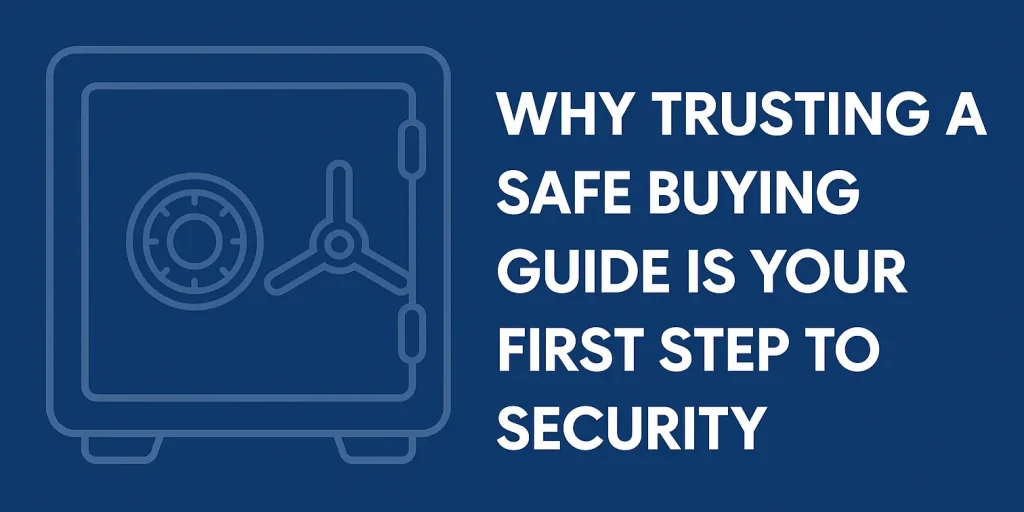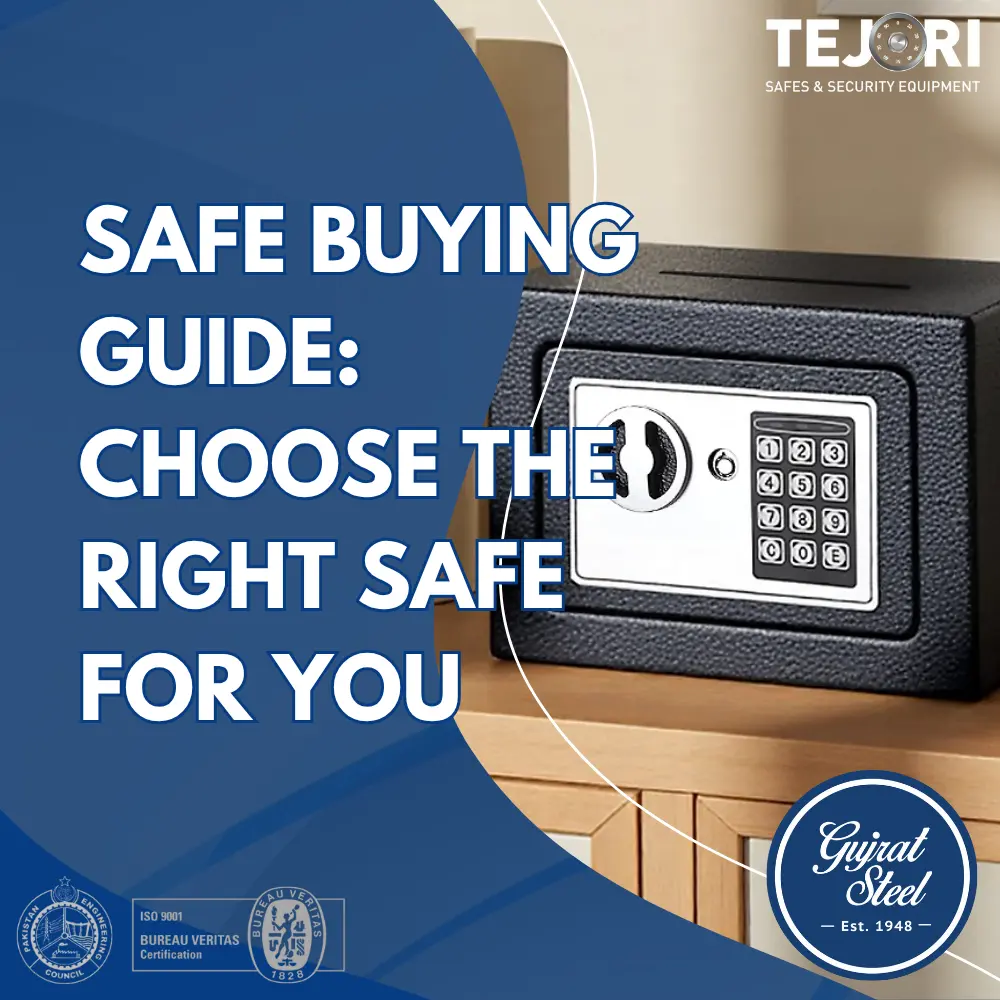This comprehensive safe buying guide is your first step toward securing your most precious belongings. A safe is a secure, lockable box used to protect valuable items against theft, fire, or water damage. At Gujrat Steel, we’ll help you understand the key features to choose the perfect one for your needs.
Key Takeaways
- First, assess what you need to protect and the primary threats (theft, fire, or both).
- Understand the difference between burglary ratings (like RSC, TL-15) and fire ratings (measured in time and temperature).
- Choose the right lock type—digital, biometric, mechanical, or key—based on your need for convenience and security.
- Always buy a safe that is larger than your current needs to accommodate future valuables.
- Ensure the safe is properly installed and bolted down, as this is critical for its effectiveness against theft.
Table of Contents
Why Trusting a Safe Buying Guide is Your First Step to Security
Welcome to Gujrat Steel, where we’ve been crafting security solutions for generations. We understand that choosing a safe isn’t just a purchase; it’s an investment in peace of mind. The market is filled with options, and it can be overwhelming to know where to start.

That’s why we’ve created this ultimate safe buying guide. Our goal is to walk you through every consideration, from size and material to lock types and fire ratings. By the end of this post, you’ll have the confidence and knowledge to select a safe that perfectly aligns with your security requirements.
We believe an informed customer is a secure customer. Let’s begin the journey of protecting your most important assets together.
Step 1: Assess Your Needs – What Are You Protecting?
Before you even look at a single safe, your first step is to take inventory. What exactly do you plan on storing inside? The contents will heavily influence the type and size of the safe you need.
Common items that people secure include cash, jewelry, important documents (passports, property deeds), electronic data, firearms, and sentimental heirlooms. Make a detailed list, as this will help you determine the internal capacity you require. Remember, it’s always wise to choose a safe that’s about 25-50% larger than you think you need; your collection of valuables will likely grow over time.
Beyond the items themselves, consider the primary threat you want to protect them from. Are you more concerned about a burglary, a fire, or potential water damage? While many safes offer protection against multiple threats, they often specialize in one area, a crucial detail we will cover in this safe buying guide.
Step 2 of Our Safe Buying Guide: Understanding Safe Types
Once you know what you’re protecting, you can explore the different types of safes available. Each is engineered for a specific purpose. At Gujrat Steel, we offer a wide range of safes and lockers to meet diverse needs.
Fireproof Safes
A fire can destroy documents and melt valuables in minutes. A fireproof safe is designed to keep its internal temperature below a certain point for a specific duration. For a deeper dive, you can read our detailed blog on understanding fire ratings for safes.
These safes are tested and rated accordingly, for example, a “1-hour fire rating at 1700°F” means the internal temperature will stay below 350°F (the point at which paper chars) for at least an hour. This is often the most critical feature for those storing irreplaceable documents like birth certificates or legal papers.
Burglary Safes
While fireproof safes protect against heat, burglary safes are built to resist physical attacks. Their construction focuses on thick, solid steel plates, especially in the door, and advanced locking mechanisms. The quality of a burglary safe is often determined by its rating from organizations like Underwriters Laboratories (UL).
A common entry-level rating is the RSC (Residential Security Container), which means the safe can withstand an attack from a single person with common tools for at least five minutes. More advanced safes have ratings like TL-15 or TL-30, indicating they can resist expert tool attacks for 15 or 30 minutes, respectively. This part of our safe buying guide is essential for those protecting high-value assets.
Gun Safes
Responsible firearm ownership includes secure storage. Gun safes are specifically designed to store rifles, handguns, and ammunition, keeping them out of the hands of children and unauthorized individuals. They often combine burglary and fire protection features.
These safes come with specialized interiors, like racking for long guns and shelving for smaller items. When considering a gun safe, it’s important to think about both security and accessibility. For more on this topic, our article on gun safety for kids provides valuable insights.
Depository Safes
Ideal for businesses that handle cash, depository safes (or drop safes) allow employees to deposit money without having access to the safe’s main contents. They feature a slot or drawer for quick deposits while the main compartment remains securely locked. This is a crucial tool for retail environments and offices to reduce the risk of internal and external theft.
Step 3: Decoding the Features – What to Look For
Now that you know the type of safe you need, it’s time to dive into the specific features. This section of our safe buying guide will help you understand the technical jargon so you can make an informed choice.
Lock Types: The Key to Your Security
The lock is the gatekeeper of your safe. There are four primary types, each with its own pros and cons.
- Mechanical/Dial Locks: These are the classic, time-tested option. They are highly reliable, don’t require batteries, and can last a lifetime. However, they can be slower to open, which might be a drawback in an emergency. If you’ve ever struggled with one, our guide on how to open a safe can offer some tips.
- Electronic/Digital Locks: These are the most popular choice today. They offer quick access via a keypad, and you can easily change the combination. Their main drawback is their reliance on batteries, though most models have external terminals for emergency power.
- Biometric Locks: Using your fingerprint for access, these are the fastest and most convenient locks. They are excellent for situations where immediate access is necessary. However, they are typically more expensive and rely on advanced technology that may require maintenance.
- Key Locks: While simple, key locks are often considered less secure for high-value items, as keys can be lost, stolen, or copied. They are usually found on smaller, more basic lockboxes.
The Importance of Steel in This Safe Buying Guide
A safe is only as strong as the material it’s made from. The thickness of the steel, especially in the door and the walls, is a primary indicator of its resistance to attack. Look for the steel gauge; a lower gauge number means thicker steel (e.g., 10-gauge is thicker than 14-gauge).
At Gujrat Steel, we emphasize the strength and durability that only high-quality steel can provide. Unlike other materials, steel offers superior resistance to drilling, prying, and cutting. To understand the fundamental differences, our blog comparing iron vs. steel is a great resource.
The construction of the door is also paramount. Look for safes with solid steel doors and multiple, large-diameter locking bolts. These bolts should extend from at least three sides of the door to provide maximum pry resistance.
Step 4: Size, Weight, and Placement
Where you plan to put your safe is just as important as the safe itself. You need to consider its physical footprint, weight, and how you will install it.
Choosing the Right Size
As mentioned earlier in this safe buying guide, always opt for a larger size than you currently need. Lay out all the items you plan to store and measure the space they occupy. Then, add at least 25% more room for future acquisitions.
Consider the external dimensions as well. Measure the space where you intend to place the safe, including doorways and stairwells it must pass through during delivery. There’s nothing worse than buying the perfect safe only to find it doesn’t fit through your door. For context on just how heavy they can be, you might find our article on how much a gun safe weighs enlightening.
The Critical Role of Installation
A small, lightweight safe can easily be carried away by a burglar to be opened elsewhere at their leisure. That’s why properly anchoring your safe is non-negotiable. Most quality safes come with pre-drilled anchor holes in the bottom.
You should bolt your safe to a solid concrete floor for maximum security. This makes it incredibly difficult for a thief to remove. If you have to install it on a wooden floor, ensure it is anchored to the floor joists. Proper installation turns a secure box into an immovable fortress.
Step 5: Common Mistakes to Avoid When Buying a Safe
Over our many years in the industry, we’ve seen customers make the same mistakes. This safe buying guide wouldn’t be complete without helping you avoid them.
- Prioritizing Price Over Protection: A cheap safe often provides a false sense of security. It’s better to invest in a quality safe with a certified rating that truly protects your valuables than to save a little money on a product that can be easily compromised.
- Ignoring Fire Ratings: Many people buy a safe for theft protection, but forget that fire is a far more common threat. Unless you are only storing items with no cash or sentimental value, a fire rating is essential.
- Buying Too Small: This is the most common regret we hear. It’s far more cost-effective to buy a larger safe from the start than to have to buy a second one later.
- Hiding a Safe Without Anchoring It: A clever hiding spot is good, but it’s no substitute for bolting the safe down. A determined burglar will find it; your goal is to make it impossible for them to take it.
By following this safe buying guide, you can navigate the purchasing process with clarity and confidence, ensuring your valuables get the protection they deserve.
Conclusion
Choosing the right safe is a significant decision for your peace of mind. By following this safe buying guide, you are now equipped with the knowledge to select a model that perfectly fits your security needs, considering everything from content and threats to lock types and installation. At Gujrat Steel, we’re here to help you protect what matters most.



